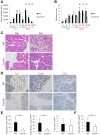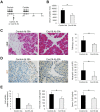Chemokine CXCL16 mediates acinar cell necrosis in cerulein induced acute pancreatitis in mice
- PMID: 29891873
- PMCID: PMC5995899
- DOI: 10.1038/s41598-018-27200-y
Chemokine CXCL16 mediates acinar cell necrosis in cerulein induced acute pancreatitis in mice
Abstract
Severe acute pancreatitis is a lethal inflammatory disease frequently accompanied by pancreatic necrosis. We aimed to identify a key regulator in the development of pancreatic necrosis. A cytokine/chemokine array using sera from patients with acute pancreatitis (AP) revealed that serum CXCL16 levels were elevated according to the severity of pancreatitis. In a mouse model of AP, Cxcl16 expression was induced in pancreatic acini in the late phase with the development of pancreatic necrosis. Cxcl16-/- mice revealed similar sensitivity as wild-type (WT) mice to the onset of pancreatitis, but better resisted development of acinar cell necrosis with attenuated neutrophil infiltration. A cytokine array and immunohistochemistry revealed lower expression of Ccl9, a neutrophil chemoattractant, in the pancreatic acini of Cxcl16-/- mice than WT mice. Ccl9 mRNA expression was induced by stimulation with Cxcl16 protein in pancreatic acinar cells in vitro, suggesting a Cxcl16/Ccl9 cascade. Neutralizing antibody against Cxcl16 ameliorated pancreatic injury in the mouse AP model with decreased Ccl9 expression and less neutrophil accumulation. In conclusion, Cxcl16 expressed in pancreatic acini contributes to the development of acinar cell necrosis through the induction of Ccl9 and subsequent neutrophil infiltration. CXCL16 could be a new therapeutic target in AP.
Conflict of interest statement
The authors declare no competing interests.
Figures







Similar articles
-
Involvement of thrombopoietin in acinar cell necrosis in L-arginine-induced acute pancreatitis in mice.Cytokine. 2012 Oct;60(1):294-301. doi: 10.1016/j.cyto.2012.05.005. Epub 2012 Jun 13. Cytokine. 2012. PMID: 22698803
-
Inhibition of Ras signalling reduces neutrophil infiltration and tissue damage in severe acute pancreatitis.Eur J Pharmacol. 2015 Jan 5;746:245-51. doi: 10.1016/j.ejphar.2014.11.020. Epub 2014 Nov 25. Eur J Pharmacol. 2015. PMID: 25460024
-
Karyopherin Alpha 2 Promotes the Inflammatory Response in Rat Pancreatic Acinar Cells Via Facilitating NF-κB Activation.Dig Dis Sci. 2016 Mar;61(3):747-57. doi: 10.1007/s10620-015-3948-6. Epub 2015 Nov 2. Dig Dis Sci. 2016. PMID: 26526450
-
The role of pro-inflammatory molecules and pharmacological agents in acute pancreatitis and sepsis.Inflamm Allergy Drug Targets. 2010 Mar;9(1):20-31. doi: 10.2174/187152810791292881. Inflamm Allergy Drug Targets. 2010. PMID: 19663805 Review.
-
MicroRNAs in acute pancreatitis: From pathogenesis to novel diagnosis and therapy.J Cell Physiol. 2020 Mar;235(3):1948-1961. doi: 10.1002/jcp.29212. Epub 2019 Sep 25. J Cell Physiol. 2020. PMID: 31552677 Review.
Cited by
-
Analysis of Pain and Analgesia Protocols in Acute Cerulein-Induced Pancreatitis in Male C57BL/6 Mice.Front Physiol. 2021 Nov 22;12:744638. doi: 10.3389/fphys.2021.744638. eCollection 2021. Front Physiol. 2021. PMID: 34880773 Free PMC article.
-
Pancreatogenic Diabetes: Triggering Effects of Alcohol and HIV.Biology (Basel). 2021 Feb 3;10(2):108. doi: 10.3390/biology10020108. Biology (Basel). 2021. PMID: 33546230 Free PMC article. Review.
-
Naa10p impairs PGC-1α/Pparγ2 interaction to inhibit mitochondrial protection in pancreatitis.J Cell Commun Signal. 2025 Jun 23;19(2):e70015. doi: 10.1002/ccs3.70015. eCollection 2025 Jun. J Cell Commun Signal. 2025. PMID: 40557397 Free PMC article.
-
Necroptosis protects against exacerbation of acute pancreatitis.Cell Death Dis. 2021 Jun 10;12(6):601. doi: 10.1038/s41419-021-03847-w. Cell Death Dis. 2021. PMID: 34112763 Free PMC article.
-
MFG-E8 Plays an Important Role in Attenuating Cerulein-Induced Acute Pancreatitis in Mice.Cells. 2021 Mar 25;10(4):728. doi: 10.3390/cells10040728. Cells. 2021. PMID: 33806041 Free PMC article.
References
Publication types
MeSH terms
Substances
LinkOut - more resources
Full Text Sources
Other Literature Sources
Molecular Biology Databases

